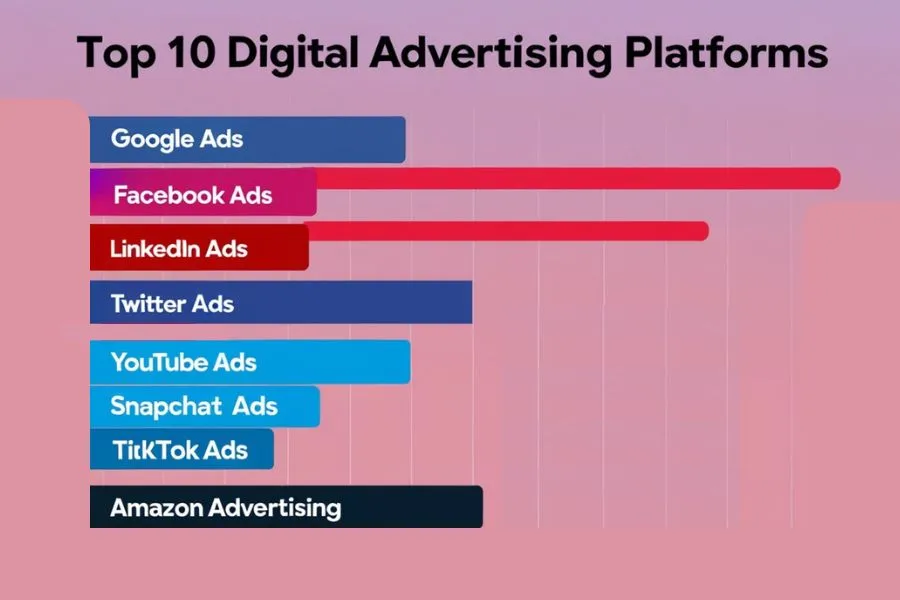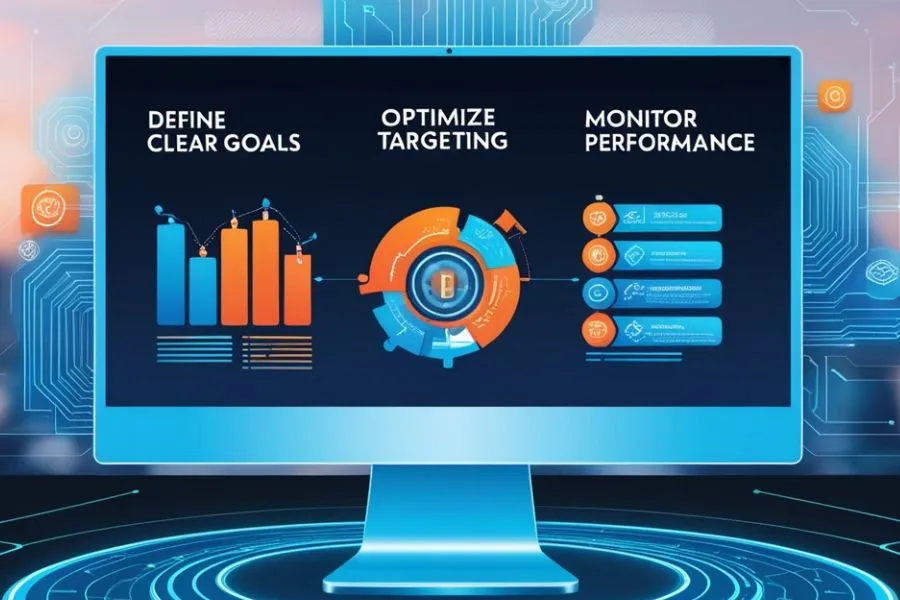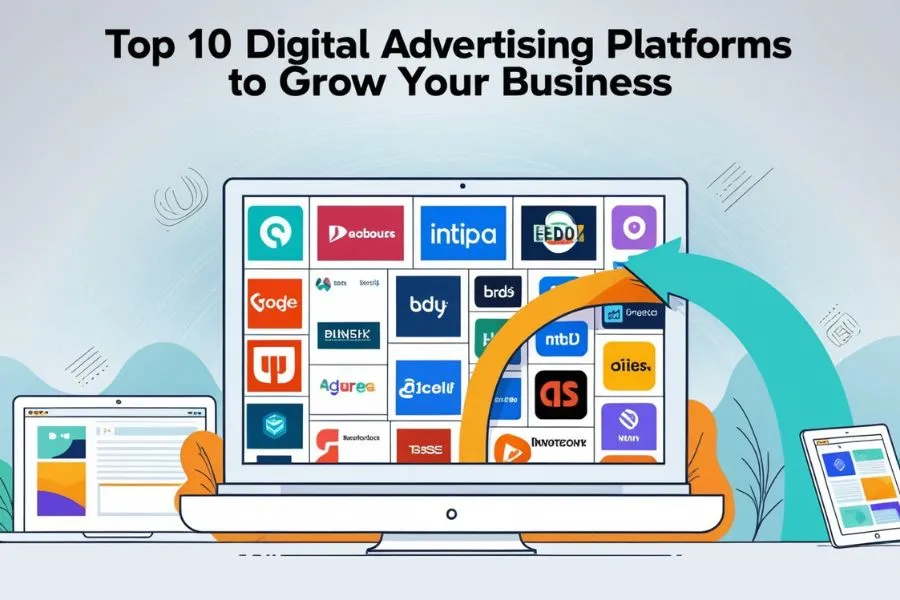Table of Contents
Digital advertising platforms are essential to reach and engage with your audience effectively. It is difficult to choose one platform from so many options. Here, we’re diving into the top 10 best digital advertising platforms that can help grow your business, with an overview of their features, how to use them, and some real-life examples. Let’s get started!
What Are Digital Advertising Platforms?
Digital advertising platforms are online tools that allow businesses to promote their products or services through ads targeted to specific audiences. These platforms range from search engines to social media sites, providing various ways to reach potential customers. By using data-driven strategies, digital advertising platforms help brands achieve their marketing goals with precision and efficiency.
Top 10 Best Digital Advertising Platforms

1. Google Ads
Google Ads is a powerhouse in digital advertising, allowing businesses to display their ads on Google search results and across the Google Display Network.
- Key Features: Advanced targeting, robust analytics, variety of ad formats (text, display, video).
- How to Use: Create a Google Ads account, choose keywords, set your bid and budget, and design your ad.
- Example: A small coffee shop might target “coffee near me” to attract local customers.
2. Facebook Ads
Facebook’s ads advanced targeting capabilities make it one of the most effective advertising platforms, especially for businesses looking to reach a diverse demographic.
- Key Features: Target by age, gender, location, and interests; detailed analytics; various ad formats including image, video, and carousel.
- How to Use: Set up an ad account, choose your audience and budget, and create a visual or video ad.
- Example: An e-commerce store could use carousel ads to showcase different products in a single ad unit.
3. Instagram Ads
Instagram advertisement is the best platform for businesses with visually appealing products or services.
- Key Features: Engaging ad formats, stories and feed ads, access to Facebook’s advanced targeting.
- How to Use: Instagram ads are managed through Facebook Ads Manager, where you can create targeted campaigns.
- Example: A fashion brand may use Instagram’s Stories ads to display their latest collection.
4. LinkedIn Ads
LinkedIn Ads is the go-to platform for B2B advertising, targeting professionals across various industries.
- Key Features: Job title and industry targeting, sponsored content, and InMail ads.
- How to Use: Set up a LinkedIn Campaign Manager account, define your audience, and create an ad.
- Example: A software company may use LinkedIn ads to target IT managers and decision-makers.
5. Twitter Ads
Twitter ads is a great platform for businesses aiming to engage audiences with trending topics or events.
- Key Features: Keyword targeting, promoted tweets, and trend targeting.
- How to Use: Define your audience, set a budget, and create promoted tweets that are relevant to trending topics.
- Example: A tech company may use Twitter ads to promote new gadgets during tech conferences.
6. YouTube Ads
If you want to get billions of video views on a daily basis then you can use video advertising by using YouTube Ads.
- Key Features: Skippable and non-skippable ads, in-stream ads, and video discovery ads.
- How to Use: Set up a Google Ads account, upload a video ad, and choose targeting options.
- Example: A fitness brand could use YouTube to share workout tutorials and showcase their products.
7. Pinterest Ads
Pinterest Ads is ideal for businesses in the fashion, home decor, and DIY sectors, where people go for inspiration.
- Key Features: Promoted pins, shopping ads, targeting by interest and keywords.
- How to Use: Create a Pinterest Business account, set your campaign objectives, and promote visually appealing pins.
- Example: A home decor store might use Pinterest to showcase its products and drive traffic to its website.
8. Snapchat Ads
Snapchat Ads reaches a younger audience, ideal for brands looking to capture the Gen Z and millennial market.
- Key Features: Story ads, filters, and interactive ad formats.
- How to Use: Set up a Snapchat Ads account, define your target audience, and create engaging, story-based ads.
- Example: A gaming company could use Snapchat’s immersive ads to launch a new game.
9. TikTok Ads
TikTok’s Ads short-form video content makes it perfect for brands targeting younger audiences with creative ads.
- Key Features: In-feed ads, branded hashtags, and TopView ads.
- How to Use: Sign up for a TikTok Ads account, create video content, and target users based on interests and behavior.
- Example: A makeup brand could use TikTok ads to launch a viral challenge featuring their products.
10. Amazon Advertising
Amazon Ads are a must for e-commerce businesses, as they help products appear directly to people shopping online.
- Key Features: Sponsored product ads, display ads, and video ads within Amazon’s ecosystem.
- How to Use: Create an Amazon Seller account, select products to promote, and set up keyword-based ads.
- Example: A new electronics brand could use Amazon Ads to increase product visibility during shopping seasons.
Benefits of Using Digital Advertising Platforms
- Increased Reach: With billions of users online, digital platforms allow you to reach vast audiences globally.
- Cost-Effectiveness: Compared to traditional media, digital ads often have a lower cost per impression and offer flexible budget options.
- Targeted Advertising: Most platforms offer advanced targeting options, so your ads are shown to the people most likely to engage with them.
How to Get Maximizing Results Using Digital Advertising Platforms

- Define Clear Goals: Whether you want clicks, leads, or sales, always set measurable goals.
Example: Suppose you’re launching a campaign for a new skincare product. Your primary goal might be to generate 1,000 website visits in the first month and convert 5% of visitors into customers. With these numbers, you can track exactly how well your ad is performing in meeting your objective.
- Optimize Targeting: Adjust your audience settings to reach the right demographic.
Example: For the skincare product, target women aged 18-35 interested in beauty and wellness. Platforms like Facebook and Instagram allow detailed targeting based on interests like “natural skincare” or “eco-friendly products.” Running A/B tests can also help you identify which audience segment engages most with your ads.
- Monitor Performance: Regularly analyze metrics to refine your campaigns and maximize ROI.
Example: Let’s say after one week, the click-through rate (CTR) is low, but the ads are receiving high impressions. Adjustments might include changing the ad copy or image to increase engagement. Also, if the cost per click (CPC) is high on Instagram compared to Facebook, you could allocate more budget to Facebook where you’re seeing better results.
Conclusion
Digital advertising platforms offer a number of opportunities to reach and engage worldwide audiences. By selecting the platforms that best suit your business and optimizing your campaigns, you can boost brand visibility, drive conversions, and ultimately grow your business. So, get started with digital advertising strategies today!
FAQs
1. What is a digital advertising platform?
A digital advertising platform is an online tool that helps businesses promote their products or services to targeted audiences.
2. Which platform is best for beginners?
Facebook Ads and Google Ads are often user-friendly for beginners due to their guided setup and flexibility.
3. How much budget is needed for digital advertising?
Budgets vary widely; many platforms allow you to start with as little as $5 per day.
4. Can I advertise on multiple platforms at once?
Yes, many businesses use multiple platforms to reach diverse audience segments and achieve different goals.
5. What’s the difference between organic and paid advertising?
Organic advertising relies on non-paid content strategies, while paid advertising involves spending on ads to reach a targeted audience.

